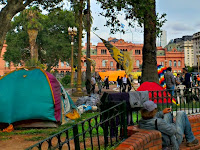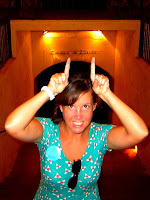




Ushuaia- 'The end of the world!'- well the most southern town in Argentina anyway. The Argentinians make it sound like it is super hard core, but the latitude is equivalent to Newcastle, and there are plenty of settlements further south. Although we were only there for five nights in total it felt like we had spent at least two weeks there. This was due to the fact that it was a small town packed with tourists, zero accommodation and the whole time was spent trying to find a bargain Antarctic tour. Hours of walking around, chats, research, phone calls and many let downs from agencies meant we felt incredibly deflated. After all, the only reason we had travelled all the way to Ushuaia from Buenos Aires was to get on a boat to Antarctica. The Submarinos (hot milk with a large chocolate flake) and the coconut chocolate cake took the edge off of the disappointment and my cold for a short while...
It's not a bad place to be stuck at all - beautiful mountains all around, bracing fresh air, glistening glaciers in sight. But it's definitely a change from relaxing in the sun on a lazy Pacific island!
We were on a mission to find a last minute space-available slot for the two of us on a trip down to Antarctica for a "reasonable" price. It's something we'd budgeted for, and we were ready to pay a certain number we'd had in mind. But, the deals were not to be found.... (easily).
There are about half a dozen actual operators that run the ships, about a dozen agents in town that all flog the very same trips with cut-throat ruthlessness, and innumerable agents overseas that resell the rest of that same inventory for crazy prices all around the world.
The various agents all did plenty of bait-and-switch, bad-mouthing competitors, using stalling techniques whilst they'd wait for stock to be released from the operators, general run-around, and bare faced lying that drove us nuts. We'd think we were booked in on a good deal - and even provide credit card details... then get an email the next morning saying "sorry... but for a few (thousand) dollars more...". Ugh. It was all extra complicated as one of the ships broke down a few weeks ago and cancelled a sailing - so all of the excess stock on other boats was GONE. There was a week of this, and it was soul destroying.
In a nutshell, we did get sorted in the end for a sailing in a few weeks - for a very good price indeed. But the trick is to go straight to the operators. Don't bother with the agents. Only the actual operators have the lee way to work with you, and as soon as they release inventory to the agents - you can get it too. And if you're nice to them, you can get right in at the head of the queue as they certainly don't mind holding onto the 20% commission that would have gone to the agents!















































